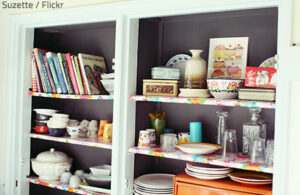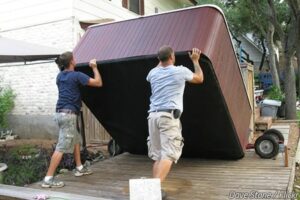We're not a moving company but we know the best movers

Whether you truly enjoy the art of cooking and spend many hours in the kitchen preparing culinary masterpieces, or prefer ready-to-cook meals that take no more than 30 minutes to prepare, the savory smell of home-made food coming from the kitchen is certain to attract the attention of all your family members and to prompt a family gathering around the dining table.
Without a doubt, the kitchen is the busiest, most appealing, and most delicious room in the home – the epicenter of family life. A functional kitchen is a symbol of a peaceful and happy home, a sign that all is the way it should be.
So, when moving to a new house, setting up the kitchen is one of the most crucial steps required to resume a normal daily routine and start feeling at home again.
To be able to do so in a quick and efficient manner, however, you need to have all your kitchen items delivered to your new place intact and well organized in properly labeled moving boxes.
This can only be achieved if you know how to pack your kitchen for moving the right way.
The kitchen is probably the trickiest room in the house when it comes to packing.
It is full of heavy, awkwardly shaped, and fragile items, many of which are quite expensive. Packing them safely for moving is a real challenge that will take up a lot of your time and energy.
To manage on time and avoid unnecessary mistakes, you need to start packing up your kitchen well ahead of Moving day and follow a practical kitchen packing checklist:
You will need a variety of quality packing materials to ensure the safety of your kitchen items during the moving process.
Make sure you have sufficient amounts of the necessary packing supplies before you get down to work, as skimping on proper packing is out of the question when it comes to delicate kitchenware but rushing into the stores for extra supplies in the last minute will cost you dearly.
You are going to need:
Once you have supplied all the required packing materials, you need to sort out and organize the numerous items in your kitchen. Only then can you begin the actual packing process.
Lorem ipsum dolor sit amet, consectetur adipiscing elit. Ut elit tellus, luctus nec ullamcorper mattis, pulvinar dapibus leo.
How to pack kitchen items? With utmost care.

Look into every drawer and every cabinet, above the shelves and under the sink, in every dark corner and small nook in your kitchen, and sort out your belongings.
The thing is that sorting out your kitchen odds and ends may take you a bit more time than you have expected.

Pianos may appear robust, yet they are delicate instruments susceptible to damage, particularly during moves. With approximately 7,000 finely tuned moving parts, even minor mishandling can cause harm.
During relocation, pianos can sustain varying degrees of damage, from surface scratches and casing cracks to broken keys and legs. In severe cases, the sound and playing mechanisms may suffer significant harm.
Adding to the challenge is the high cost associated with pianos. On average, upright pianos range from $3,000 to $7,000, while premium models can reach $10,000 to $25,000.
Considering the potential sentimental value of pianos, it’s prudent to engage professional piano movers rather than risking damage with non-specialists.

Moving a hot tub can be daunting. When relocating, you’re faced with the dilemma of leaving it behind or hiring movers. Given its size, it’s understandable. But worry not! Professional movers specialize in hot tub transportation, ensuring a smooth transition to your new home. Don’t let its bulk deter you; with expert assistance, moving your beloved Jacuzzi becomes hassle-free.
Moving a hot tub presents challenges due to its significant size, making DIY relocation risky. Spa manufacturers offer three size categories: small, medium, and large. Small tubs are suitable for 2-4 people, medium for 5-6, and large for 7+ individuals. Each size category has specific dimensions, ensuring an ideal fit for different needs. Considering the size alone, it’s advisable to avoid attempting DIY moves to prevent accidents and damage.
Moving a hot tub presents challenges due to its large dimensions and substantial weight. Larger spas naturally weigh more, with small ones weighing around 500 pounds empty and up to 3,000 pounds when filled. Larger spas for 7+ people can weigh close to 1,000 pounds empty and up to 6,000 pounds when filled. However, hot tubs are always drained of water before transport, alleviating some weight concerns.
For a safe hot tub relocation, hiring experienced hot tub movers is essential. Professionals possess the skills and equipment needed for a secure transfer. Due to the large dimensions and weight, DIY moves pose risks of damage or injury. Entrusting the task to experts ensures a smooth and safe relocation process. With their expertise, potential accidents and costly damages are mitigated. Invest in professional movers for a hassle-free hot tub move to your new home.

Having a pool table at home adds fun for family and friends. When moving to a new home, you’d naturally want to keep it. However, pool tables are challenging to move due to various reasons. It’s essential to plan and prepare adequately for a smooth relocation.
Moving a pool table involves meticulous disassembly, protection, and reassembly, challenging without the necessary skills and experience. Key steps include unfastening pockets, detaching rails, removing felt, slate, and finally, the frame and legs. Each phase demands precision to ensure safe relocation.
Moving a pool table is challenging due to the weight of its slates. There are three main sizes: 7, 8, and 9-foot slate pool tables, with weight influenced by size and slate count. Typically, slate pool tables weigh between 650 and 1,000 pounds. Factors affecting weight include slate type, table size, slate thickness, and table structure. Slates alone can weigh 150-250 pounds each, and a standard table has three slates. The table body can weigh up to 200 pounds, with each leg weighing 10-20 pounds and rails 10-15 pounds each.
Damaging your pool table’s felt during removal isn’t the end of the world—you can easily replace it. The real challenge lies with the table’s slates. Despite being made from rock, these slates are surprisingly fragile and prone to damage if dropped or knocked against something during the move. For a pool table with three slates, remember that damaging just one means replacing all three, as they’re designed to fit together perfectly. Opting for professional pool table movers might seem like an added expense, but it’s often more cost-effective than replacing all three slates due to accidental damage.

Damaging a pool table’s felt during disassembly is manageable with a simple replacement. However, the real challenge arises with the slates—despite being made of rock, they’re surprisingly brittle and susceptible to damage during transport. A single crack in one of a 3-slate pool table necessitates the costly replacement of all three to ensure a perfect match. Consequently, the expense of replacing these slates often outweighs the cost of professional pool table movers. Similarly, moving large metal safes poses a significant challenge due to their extreme weight and design intended to deter unauthorized removal. This irony becomes apparent when attempting to relocate such a heavy, secure item yourself.
When moving, focus on large professional safes rather than lightweight, portable models. These can weigh between 200 to 400 pounds, with gun safes averaging around 600 pounds. Factors like fireproof ratings, thicker inner steel, and added drawers increase a safe’s weight. Consequently, the heavier the safe, the more challenging it is to remove from a home.
When moving house, the focus should be on relocating large professional safes, not the small, portable ones. These hefty units can weigh between 200 to 600 pounds, with gun safes averaging around 600 pounds. Factors like fireproof ratings, thicker inner steel, and additional drawers can significantly increase a safe’s weight. The bulkier the safe, the more challenging it is to move. For those planning to move an extra-large safe, understanding its exterior dimensions is crucial for proper handling. For instance, a large home safe might measure 59 inches in height, 29.25 inches in width, and 25.50 inches in depth, highlighting the need for careful planning and execution during the move.
Moving a large, high-security safe, comparable in size to a refrigerator but significantly heavier, requires careful planning and professional assistance to mitigate risks. Essential equipment, like a heavy-duty appliance dolly, is necessary for transportation. Enlisting the help of friends is crucial for managing its weight. Planning a clear exit route and moving strategy is vital to avoid accidents, while protecting the safe, walls, and floors is imperative. The complexities of moving a heavy safe up or down stairs highlight the dangers of attempting a DIY move.

A grandfather clock, with its elegance and beauty, stands as a valuable heirloom passed down through generations, often being the most prized possession in a home. However, the challenge of moving such a fragile, long-case freestanding pendulum clock without inflicting permanent damage is a major concern when relocating. Their delicate nature makes them one of the hardest items to safely transport between homes.
Moving to a new home? Don’t forget about your beloved grandfather clock! Despite its majestic appearance, these timepieces are delicate and require careful handling during relocation. Glass elements are prone to breakage, and delicate mechanisms need protection. Safely removing weights and pendulum before moving is crucial to prevent damage. Trust me to ensure your grandfather clock arrives at its new home safely.
Moving a grandfather clock presents unique challenges that require careful packing to prevent damage. Following specific packing steps in the right order is crucial for ensuring the safety of this delicate item. Start by inspecting the clock and assessing risks. Protect cables/chains, remove and label weights correctly. Secure hanging chains and remove pendulum. Safeguard the pendulum guide. Next, protect chime rods, remove glass shelves/ornaments, and pack pendulum/weights separately. Finally, safeguard frontal glass sections and wrap the clock in thick blankets. Need detailed instructions? Click the link for expert guidance on safely packing and moving a grandfather clock.


